Phone +49 2632 98750 | ||
 | ||
Similar Sita Wagner GmbH, Wertstoffh Neuwied, Vallendar, Koblenzer Entsorgu und Verw, Stadtverw Bendorf Profiles | ||
The Volcano Park in Mayen-Koblenz (German: Vulkanpark) is a geopark in the rural district of Mayen-Koblenz in the eastern Vulkan Eifel, Germany. It was founded in 1996 and wraps around the Laacher See (between Brohl-Lützing, Andernach, Plaidt, Mendig and Mayen). Together with the Volcano Park, Brohltal/Laacher See and the Vulkan Eifel Nature and Geo-Park, it forms part of the national Eifel Volcano Land Geo-Park (Geopark Vulkanland Eifel). The three parks are connected by the 280-kilometre-long German Volcano Route.
Contents
The Volcano Park illustrates volcanism in the Eifel, how the present-day landscape developed, and the exploitation of basalt, pumice and tuff since Roman times. It incorporates exhibits on volcanology, archaeology and industrial history, with educational trails and information signs. The museum incorporates a total of 25 stations, which can be combined in a single visit using four roads plus hiking and bicycle paths.
On 10 July 2010, the Volcano Park was honoured with the "European Union Cultural Heritage Prize" of the heritage protection organisation Europa Nostra, in the category of "Education, Instruction, Training and Consciousness Building". In 2003, the park's project at the Meurin Roman mine had won the same prize.
In 2010 the park had a record 220,000 visitors.
Blue Route - Plaidt
Central departure point in Plaidt: information centre and museum with exhibits on the development of the Eifel mountains and the history of quarrying and mining
Tuff deposits from the Laacher See volcanic eruption
Built of tuff from the Meurin mine
Red Route - Mendig
Museum with information on the history of volcanism and the geological history of the region
3 square kilometres of chambers hewn out of the volcanic rock 32 metres under the town of Mendig
Open-air exhibit on the life of mine workers extracting and processing basaltic lava
Cliff-face 50 metres high which records volcanological information about the eruption of the Laacher See volcano
Yellow Route - Andernach
Tallest cold-water geyser in the world
Exhibit of historical products made of basaltic lava and tuff
Former volcano at the Eich district of Andernach.
Built of tuff from the Meurin mine
Contains finds from the prehistoric and historic, including Roman, periods
Erosion has created a unique view of the interior of a 230,000-year-old volcano
Roman quarry in the lava flow from the Veitskopf volcano
Volcano whose basalt was used for construction in the Roman period and the early Middle Ages, for example in the Roman bridge at Trier
Green Route - Mayen
Quarry where Mayen Basalt Lava is extracted from the major lava field of the Bellerberg volcano
Bizarre rock formations created by the eruption of the Hochsimmer volcano
Former site of basalt and tuff mining operations with remains of cranes, crane platforms, railway lines and buildings
West and east flanks of the large Bellerberg volcano
Oldest and most important source of Mayen Basalt Lava
Site of the largest late Roman hill fort in the Eifel and Hunsrück
